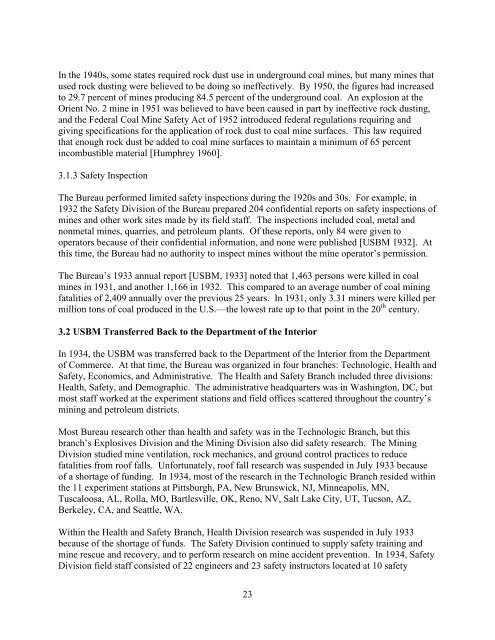One Hundred Years of Federal Mining Safety and Health Research
One Hundred Years of Federal Mining Safety and Health Research
One Hundred Years of Federal Mining Safety and Health Research
- No tags were found...
You also want an ePaper? Increase the reach of your titles
YUMPU automatically turns print PDFs into web optimized ePapers that Google loves.
In the 1940s, some states required rock dust use in underground coal mines, but many mines that<br />
used rock dusting were believed to be doing so ineffectively. By 1950, the figures had increased<br />
to 29.7 percent <strong>of</strong> mines producing 84.5 percent <strong>of</strong> the underground coal. An explosion at the<br />
Orient No. 2 mine in 1951 was believed to have been caused in part by ineffective rock dusting,<br />
<strong>and</strong> the <strong>Federal</strong> Coal Mine <strong>Safety</strong> Act <strong>of</strong> 1952 introduced federal regulations requiring <strong>and</strong><br />
giving specifications for the application <strong>of</strong> rock dust to coal mine surfaces. This law required<br />
that enough rock dust be added to coal mine surfaces to maintain a minimum <strong>of</strong> 65 percent<br />
incombustible material [Humphrey 1960].<br />
3.1.3 <strong>Safety</strong> Inspection<br />
The Bureau performed limited safety inspections during the 1920s <strong>and</strong> 30s. For example, in<br />
1932 the <strong>Safety</strong> Division <strong>of</strong> the Bureau prepared 204 confidential reports on safety inspections <strong>of</strong><br />
mines <strong>and</strong> other work sites made by its field staff. The inspections included coal, metal <strong>and</strong><br />
nonmetal mines, quarries, <strong>and</strong> petroleum plants. Of these reports, only 84 were given to<br />
operators because <strong>of</strong> their confidential information, <strong>and</strong> none were published [USBM 1932]. At<br />
this time, the Bureau had no authority to inspect mines without the mine operator’s permission.<br />
The Bureau’s 1933 annual report [USBM, 1933] noted that 1,463 persons were killed in coal<br />
mines in 1931, <strong>and</strong> another 1,166 in 1932. This compared to an average number <strong>of</strong> coal mining<br />
fatalities <strong>of</strong> 2,409 annually over the previous 25 years. In 1931, only 3.31 miners were killed per<br />
million tons <strong>of</strong> coal produced in the U.S.—the lowest rate up to that point in the 20 th century.<br />
3.2 USBM Transferred Back to the Department <strong>of</strong> the Interior<br />
In 1934, the USBM was transferred back to the Department <strong>of</strong> the Interior from the Department<br />
<strong>of</strong> Commerce. At that time, the Bureau was organized in four branches: Technologic, <strong>Health</strong> <strong>and</strong><br />
<strong>Safety</strong>, Economics, <strong>and</strong> Administrative. The <strong>Health</strong> <strong>and</strong> <strong>Safety</strong> Branch included three divisions:<br />
<strong>Health</strong>, <strong>Safety</strong>, <strong>and</strong> Demographic. The administrative headquarters was in Washington, DC, but<br />
most staff worked at the experiment stations <strong>and</strong> field <strong>of</strong>fices scattered throughout the country’s<br />
mining <strong>and</strong> petroleum districts.<br />
Most Bureau research other than health <strong>and</strong> safety was in the Technologic Branch, but this<br />
branch’s Explosives Division <strong>and</strong> the <strong>Mining</strong> Division also did safety research. The <strong>Mining</strong><br />
Division studied mine ventilation, rock mechanics, <strong>and</strong> ground control practices to reduce<br />
fatalities from ro<strong>of</strong> falls. Unfortunately, ro<strong>of</strong> fall research was suspended in July 1933 because<br />
<strong>of</strong> a shortage <strong>of</strong> funding. In 1934, most <strong>of</strong> the research in the Technologic Branch resided within<br />
the 11 experiment stations at Pittsburgh, PA, New Brunswick, NJ, Minneapolis, MN,<br />
Tuscaloosa, AL, Rolla, MO, Bartlesville, OK, Reno, NV, Salt Lake City, UT, Tucson, AZ,<br />
Berkeley, CA, <strong>and</strong> Seattle, WA.<br />
Within the <strong>Health</strong> <strong>and</strong> <strong>Safety</strong> Branch, <strong>Health</strong> Division research was suspended in July 1933<br />
because <strong>of</strong> the shortage <strong>of</strong> funds. The <strong>Safety</strong> Division continued to supply safety training <strong>and</strong><br />
mine rescue <strong>and</strong> recovery, <strong>and</strong> to perform research on mine accident prevention. In 1934, <strong>Safety</strong><br />
Division field staff consisted <strong>of</strong> 22 engineers <strong>and</strong> 23 safety instructors located at 10 safety<br />
23
















